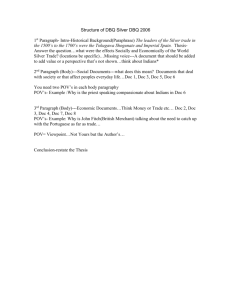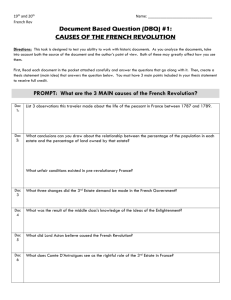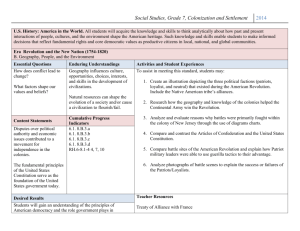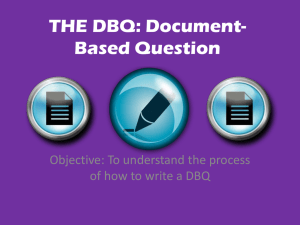File - AP World History (WHAP)
advertisement
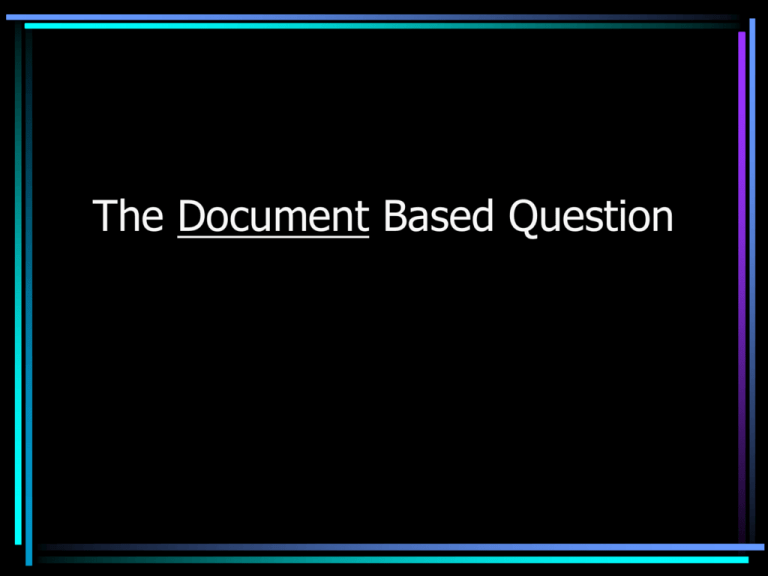
The Document Based Question What do I need to know about history? •Nothing •The more you know the better your essay will be, but it is still possible to get a 9 without knowing much at all. – All the information you will need to complete your essay is contained in the document. – It is your job to organize, interpret, and analyze these documents. – Writing the DBQ (Document Based Question) is a skill and like all other skills, it can be learned. First 10 Minutes • Reading and organizing time, i.e. you cannot write in your little pink essay booklet. • Spend this 10 minutes working on the DBQ since this essay requires the most reading and preparation time. Your question book will look like this—except say World History (I hope) Pre-Write • Find the question. It is usually at the end of the page. underline key terms and parameters (dates and places) Example: 1. Using the following documents, analyze the causes and consequences of the Green Revolution in the period from 1945 to the present. Identify and explain one additional type of document and explain how it would help your analysis of the Green Revolution. Historical Background: The Green Revolution refers to the worldwide introduction of new, scientifically bred crop varieties and intensive use of new technologies. • These key words will be a unifying link throughout the essay. • The timeframe is unimportant because all of the documents will deal with that time. • The other document is important but not just yet… Pre-Write cont. • Key Words and Parameters? – Causes and Consequences – Green Revolution – 1945-Present – No region mentioned. So… all your documents should be 1945-present. Pay attention to the dates on the documents if listed. All are about the Green Revolution. What are you looking for when you read them? Causes and Consequences Causes=why something happened Consequences=results—NOT always bad It is easy! But– YOU MUST DO YOUR PRE-WRITING! • 1. Read the question. – Underline key words in the question. • 2. Read and summarize the documents. • 3. Organize Now let’s set up our PI chart Groups Doc #s POV and AD for Each Group Read the documents looking for…. • Each document should show a cause, or a consequence. (they may even show both). Read them and summarize them out to the side. • Do you see an answer there (cause or consequence)? You should—they wrote the dbq so you could find one. • The part about the additional documents is a reminder—you know you need three of these. • Historical Background is there to help you. Read it, but it may not be important—depending on how much you know. Make sure you have a print out of the documents to go on. • Do your summarizing and then go on with the video—you are then going to check them. Doc. #1 • Graph • Shows wheat yields went up in India and Mexico steadily went up from from 1950-2005 • POV info: Source FAQ of United nations 2005. Prob. reliable—not much to go on here. Doc #2 • Graph • Shows that World Population and food supply have been increasing at about the same rate since about 1970. Also shows a slightly higher population than food supply from about 1930-1960. Finally, this graph shows a prediction of both continuing to grow at the same rate until 2050– from looking at this graph we think—although the population continues to grow food supply will also grow. • POV info: Same source and year as doc #1 Assumes that pop and food will grow at present rate. Doc #3 • Says people are starving in 1949 and that the united states should help other countries to produce more food through the use of our technology and knowledge. • POV info: Harry Truman (president) during inaugural address. Speech to motivate Americans about how great they are and motivate them to help “Free” nations—cold war influence. (date is 1949) Doc #4 • Cause—land is tired no nutrients left, poor nations are starving, but with implementation of the green revolution we will have more food. Also says population growth needs to be slowed. • POV: As a scientist that began the process, his name being synonymous with the Green Revolution, he would believe in it. However, he does not show humility. He clearly believes this is not the only needed solution to the problem. Doc #5 • Gave credit for the green revolution success in India to the farmers in Punjab. Their initiative and energy helped caused it to work. • POV: 1970—so beginning of success. His praise may be directed at making the farmers feel ownership, or to make that region continue to get behind the changes in Agriculture. Doc #6 • Consequence—wealth in the region of Mexico where the growth of food has increased due to the green revolution. • POV Ideas: She is the wife of a Mexican agricultural official. She may see how the land owners and officials are getting wealthy, but might miss the effects on the average Mexican. Doc #7 • Makes the land owners rich, but that for some groups it is actually worsening their situation. Especially for women in rural areas. • POV ideas: You can bring up the fact that these problems may have more to do with the continued female subjugation of women—not the green revolution. Doc #8 • List many negative consequences—once again mentions lower classes are not helped economically. • Mentions the Punjab again—this time the “competition” mentioned in the previous doc. is now violent. • Water resources diminishing and causing conflict. • POV Ideas: You have a few here—first, she is an Indian living in India, so she would be aware of the situation in the Punjab. Her article was published in an environmental magazine. Such magazines are against using chemicals in farming so they might be sensationalizing the issue…. Doc. #9 • The Green Revolution has really increased the standard of living for the people in the Punjab. • Family system has changed—traditions changing—from extended family to nuclear family. • POV Ideas: This report was probably researched well and can be trusted, however the information could have been skewed to show only the positive. Politicians could be supported by the commercial farming industry. Doc. #10 • The green revolution is reducing the diversity of seeds and we are losing plants wants native to areas now using Green Revolution techniques. • POV: The writer feels this way because globalization is marginalizing his culture… Pause this video and do your chart. Some pointers: • Be specific. Don’t use general themes and don’t use good and bad or negative and positive. • Have at least three groups. Never leave a document alone until you have three. • Remember your groups are your thesis. Did you check? • • • • Have you answered the question asked? Did you use all the documents? Do you have at least 3 groups? Do you have Additional Documents that you can justify? My groups— PS: you can make these line up better when you aren’t doing ppt. *Need for food and increase in scientific knowledge. 2, 3, 4 Improved Standards of living in some. 1,2,4, 5, 6, 9 (7 and 8 could also be used) Problems and conflict in society. 7, 8 (9?) Ecological Problems 8, 10 3—cold war AD: Map or graph showing areas of soil degradation to see if there was a dire need for chemical fertilizer. 6, is the best choice—can do more. AD: Survey of laborers to see if their standard of living has improved. Or graph showing changes in salary for workers to see if their standard of living has improved. 8, AD: Interview of people in different castes… 10, AD: Agricultural Scientist commenting on the loss of seed diversity or a chart showing loss of diversity. Now we can WRITE II know you will go over your ten minutes. Watch the time, but your prewrite will actually save you time. Formula • • • • • Thesis Group One – Documents supporting this group (summarized and analyzed) – POV on one doc – Additional doc Group Two – Documents supporting this group(summarized and analyzed) – POV on one doc – Additional doc Group Three – Documents supporting this group(summarized and analyzed) – POV on one doc – Additional doc Conclusion Remember—Write Fast! Standiford’s Thesis • From 1945 to the present the world has experienced a third agricultural revolution. The “Green” revolution is still being criticized and debated. People want to know if it saved us or will it end up causing more problems in the long run. The documents show that this revolution was caused by advances in technology and the need for more food. They show that the need for more food has been met and that many have been able to raise their standard of living. However, they also show that the Green Revolution has resulted in extreme ecological damage, changes in society, and an increase in conflict. • • ***Note: the beginning is just an intro. The thesis is the yellow. You don’t need the intro. However, do you see I used the words from the question? Important! Body Paragraph One • Documents 2, 3, and 4 show that people were starving and we could not provide enough food for a growing population. Doc. 2 is a graph showing that the population exceeded the food supply from the 1920’s until approximately 1950. Doc. 3 is a speech motivating the people of the United States to help those much less fortunate by explaining that they are going hungry and need American technology and investment. Of course this was during the cold war and the Truman wanted to be seen as the world’s savior in order to gain favor over USSR. (POV) Doc. 4 explains that before the green revolution people were starving and that traditional methods of farming weren’t working due to soil degradation. An additional document that might help to see whether the soil degradation was increasing would be a map or graph comparing soil degradation by region. Body Paragraph Two • Documents 1,2,4,5,6, and 9 all show that the green revolution has generally raised standards of living for many. Doc. 1 and 2 both show that food supply has grown globally and specifically in Mexico were the Green revolution started. Doc. 4 says that many poor nations will no longer be hungry. Doc. 5 says that not only can people in the Punjab grow more food, but that it has provided a way to increase their ability to be innovative and learn new technology. Doc. 6 credits the Green Revolution with increased wealth in Mexico. However, it must be noted that this is from the wife of an agricultural official. She is observing the elite, not the average farmer or agricultural worker. (pov). Doc. 9 States that through the adoption of green revolution methods people in the Punjab have better education and housing and has created more of a middle class. An additional document that might support or refute this might be an interview or survey from average households and agricultural laborers asking about changes to their standard of living. Or a graph showing rising standard’s of living in lower classes over time. Body Paragraph Three • Documents 7 and 8 show negative effects from the Green Revolution on society. Doc. 7 states that especially for women the changes have actually worsened their situation. That it has increased the poverty and decreased the chances for work in the working classes. However, this document seems to place all the burden on agriculture while ignoring the cultural reasons for these problems. Doc. 8 lists many negatives that the Green Revolution has created. Poverty for the rural working class and conflict because of this gap between the rich and poor and scarce water supplies. And additional document that might help would be an interview of people in the Punjab or in Mexico to see if they feel there is a greater gap in wealth and if this is increasing conflict. Body Paragraph Four • Documents 8 and 10 list many negative environmental consequences of the Green Revolution. Doc. 8 blames the revolution for decrease in diversity, water shortages, pestinfested crops and more. Doc. 10 says that we are losing native seeds and that the green revolution techniques are causing reduce our seed diversity. Doc. 10 is written by a group of people whose culture is being marginalized. They would believe that losing native seeds as negative because they see losing any of their traditional culture is bad. However, many farmer that are not Mayan may not feel that this is a significant loss. (pov) An additional document that might be would be from an agricultural scientist showing the link between the G. R. on the loss of seed diversity or a chart showing loss of diversity. Conclusion • Re-answer your question with your groups. • In most cases your conclusion should be more than a restating of your thesis, but in this case… • Do you know more than what was in the documents and haven’t shown it? Now’s your time. Hopefully you are getting the idea. • Remember—this is the longest essay. You must show understanding AND evidence. You must do one POV at least per group and one additional document per group. • Time yourself and practice. Use old DBQ’s like I just did. • Now that you have the DBQ done it is time to move to the other questions.

